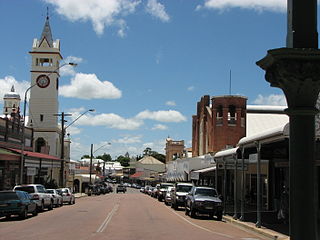
Charters Towers is a rural town in the Charters Towers Region, Queensland, Australia. It is 136 km (85 mi) by road south-west from Townsville on the Flinders Highway. During the last quarter of the 19th century, the town boomed as the rich gold deposits under the city were developed. After becoming uneconomical in the 20th century, profitable mining operations have commenced once again. In the 2016 census, Charters Towers had a population of 8,120 people.

Ravenswood is a rural town and locality in the Charters Towers Region, Queensland, Australia. In the 2016 census, the locality of Ravenswood had a population of 255 people.
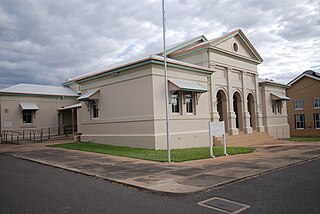
Charters Towers Courthouse is a heritage-listed courthouse at 28 Hodgkinson Street, Charters Towers City, Charters Towers, Charters Towers Region, Queensland, Australia. It was designed by John James Clark and built in 1886 by Charles Miller. It is also known as Charters Towers Courthouse. It was added to the Queensland Heritage Register on 21 October 1992.

Charters Towers Stock Exchange Arcade is a heritage-listed shopping arcade at 76 Mosman Street, Charters Towers City, Charters Towers, Charters Towers Region, Queensland, Australia. It was designed by Sydney architect Mark Cooper Day and built in 1888 by Sandbrook Brothers of Sydney. It was originally known as the Royal Arcade. It was added to the Queensland Heritage Register on 21 October 1992.

St Paul's Anglican Church is a heritage-listed church at 178-202 Adelaide Street, Maryborough, Fraser Coast Region, Queensland, Australia. It was designed by Francis Drummond Greville Stanley and built from 1878 to 1921. It was added to the Queensland Heritage Register on 21 October 1992.

St John's Lutheran Church is a heritage-listed church at 30 George Street, Bundaberg South, Bundaberg, Bundaberg Region, Queensland, Australia. It was designed by Karl Langer and built in 1960 by J Hutchinson and Sons. It was added to the Queensland Heritage Register on 7 December 2012.

St Mary's Anglican Church is a State heritage-listed church at 11 Gordon Street, Mount Morgan, Rockhampton Region, Queensland, Australia. It was designed and built in 1888–1889 by Scottish-born Thomas Glen Cornes (1842–1903), superintendent of sawmills and carpenters at the Mount Morgan Gold Mining Company Limited. It was added to the Queensland Heritage Register on 25 August 2000.

Totley Township is a heritage-listed mining camp at Charters Towers Mining District, Ravenswood, Charters Towers Region, Queensland, Australia. It was built from c. 1883 to c. 1964. It is also known as Great Extended Mill, Great Extended Mine, and King's New Mill & Tramway. It was added to the Queensland Heritage Register on 21 October 1992.
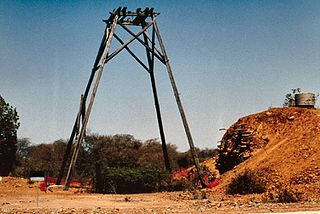
London North Mine is a heritage-listed mine at Elphinstone street, Ravenswood, Charters Towers Region, Queensland, Australia. It was built from c. 1903 to 1915. It was added to the Queensland Heritage Register on 22 February 1994.

Ravenswood Community Church is a heritage-listed former Roman Catholic church and now union church at Chapel Street, Ravenswood, Charters Towers Region, Queensland, Australia. It was built in 1871 by Ross & O'Reilly. It is also known as St Patrick's Catholic Church. It was added to the Queensland Heritage Register on 24 September 1999.
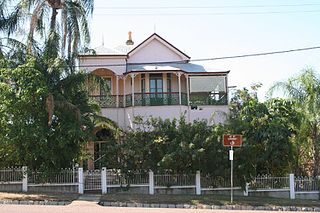
Ay Ot Lookout is a heritage-listed villa at 63 Hodgkinson Street, Charters Towers City, Charters Towers, Charters Towers Region, Queensland, Australia. It was designed by William White and built in the 1890s. It was added to the Queensland Heritage Register on 21 October 1992.

Pfeiffer House is a heritage-listed detached house at 2–6 Paull Street, Charters Towers City, Charters Towers, Charters Towers Region, Queensland, Australia. It was built c. 1881. It is also known as Church of Jesus Christ of Latter Day Saints and Day Dawn House. It was added to the Queensland Heritage Register on 21 October 1992.

ED Miles Mining Exchange is a heritage-listed commercial building at 65 Mosman Street, Charters Towers City, Charters Towers, Charters Towers Region, Queensland, Australia. It was designed by William George Smith junior, and built in 1887 by Ben Toll. It was added to the Queensland Heritage Register on 9 November 2012.

The Bell Tower of St Columba's Church is a heritage-listed bell tower of the Catholic Church located at 134 Gill Street, Charters Towers City, Charters Towers, Charters Towers Region, Queensland, Australia. It was designed by Charles William Smith and built from 1897 to 1898. It was added to the Queensland Heritage Register on 21 October 1992.

Mining works on Towers Hill is a heritage-listed group of mining ruins at Towers Hill, Charters Towers, Charters Towers Region, Queensland, Australia. They were built from 1872 to 1940s. They are individually known as Pyrites Works, Rainbow Battery, and Towers Chlorination Works. They were added to the Queensland Heritage Register on 29 April 2003.
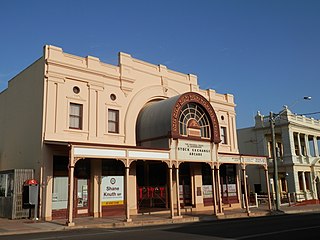
Charters Towers City is the central suburb and central business district of the town of Charters Towers in the Charters Towers Region, Queensland, Australia. In the 2016 census, Charters Towers City had a population of 2,134 people.
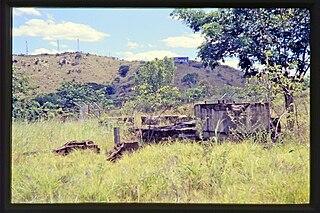
Day Dawn mine remains is a heritage-listed mine ruins at Paull Street, Charters Towers City, Charters Towers, Charters Towers Region, Queensland, Australia. It was built from 1891 to 1913. It was added to the Queensland Heritage Register on 29 April 2003.

Charters Towers mine shafts are a heritage-listed group of mine shafts and ruins at Charters Towers, Charters Towers Region, Queensland, Australia. It was built from 1883 to 1916. It was added to the Queensland Heritage Register on 29 April 2003.

Ravenswood Mining Landscape and Chinese Settlement Area is a heritage-listed former mining town and archaeological site on the reserve bounded by School Street, Cemetery Road, Railway Street and Burdekin Falls Dam Road, Ravenswood, Charters Towers Region, Queensland, Australia. It was added to the Queensland Heritage Register on 14 October 2016.

Chapel Street Bridge is a heritage-listed road bridge at Chapel Street, Ravenswood, Charters Towers Region, Queensland, Australia. It was built from 1895 to 1898. It was added to the Queensland Heritage Register on 29 November 2019.























